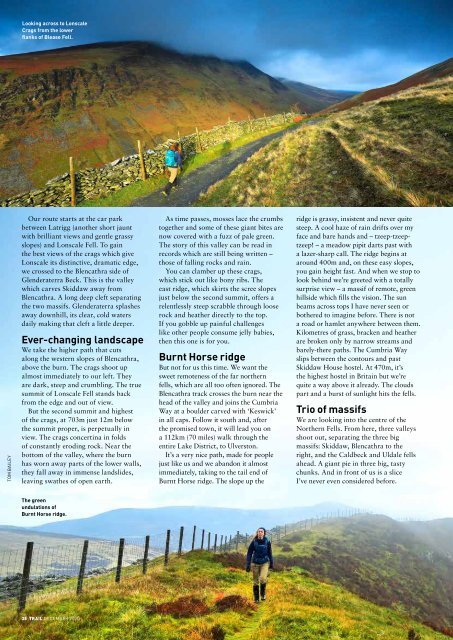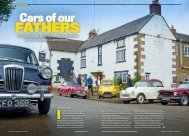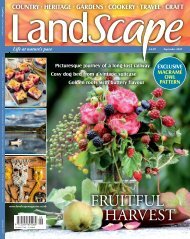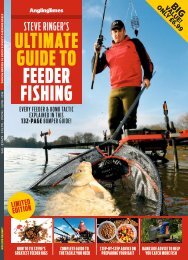You also want an ePaper? Increase the reach of your titles
YUMPU automatically turns print PDFs into web optimized ePapers that Google loves.
Looking across to Lonscale<br />
Crags from the lower<br />
flanks of Blease Fell.<br />
LAKE DISTRICT<br />
“THE SUN BEAMS<br />
ACROSS TOPS I’VE NEVER<br />
SEEN OR BOTHERED TO<br />
IMAGINE BEFORE”<br />
Lonscale Fell’s nose<br />
is as well defined as<br />
any model profile.<br />
TOM BAILEY<br />
Our route starts at the car park<br />
between Latrigg (another short jaunt<br />
with brilliant views and gentle grassy<br />
slopes) and Lonscale Fell. To gain<br />
the best views of the crags which give<br />
Lonscale its distinctive, dramatic edge,<br />
we crossed to the Blencathra side of<br />
Glenderaterra Beck. This is the valley<br />
which carves Skiddaw away from<br />
Blencathra. A long deep cleft separating<br />
the two massifs. Glenderaterra splashes<br />
away downhill, its clear, cold waters<br />
daily making that cleft a little deeper.<br />
Ever-changing landscape<br />
We take the higher path that cuts<br />
along the western slopes of Blencathra,<br />
above the burn. The crags shoot up<br />
almost immediately to our left. They<br />
are dark, steep and crumbling. The true<br />
summit of Lonscale Fell stands back<br />
from the edge and out of view.<br />
But the second summit and highest<br />
of the crags, at 703m just 12m below<br />
the summit proper, is perpetually in<br />
view. The crags concertina in folds<br />
of constantly eroding rock. Near the<br />
bottom of the valley, where the burn<br />
has worn away parts of the lower walls,<br />
they fall away in immense landslides,<br />
leaving swathes of open earth.<br />
As time passes, mosses lace the crumbs<br />
together and some of these giant bites are<br />
now covered with a fuzz of pale green.<br />
The story of this valley can be read in<br />
records which are still being written –<br />
those of falling rocks and rain.<br />
You can clamber up these crags,<br />
which stick out like bony ribs. The<br />
east ridge, which skirts the scree slopes<br />
just below the second summit, offers a<br />
relentlessly steep scrabble through loose<br />
rock and heather directly to the top.<br />
If you gobble up painful challenges<br />
like other people consume jelly babies,<br />
then this one is for you.<br />
Burnt Horse ridge<br />
But not for us this time. We want the<br />
sweet remoteness of the far northern<br />
fells, which are all too often ignored. The<br />
Blencathra track crosses the burn near the<br />
head of the valley and joins the Cumbria<br />
Way at a boulder carved with ‘Keswick’<br />
in all caps. Follow it south and, after<br />
the promised town, it will lead you on<br />
a 112km (70 miles) walk through the<br />
entire Lake District, to Ulverston.<br />
It’s a very nice path, made for people<br />
just like us and we abandon it almost<br />
immediately, taking to the tail end of<br />
Burnt Horse ridge. The slope up the<br />
ridge is grassy, insistent and never quite<br />
steep. A cool haze of rain drifts over my<br />
face and bare hands and – tzeep-tzeeptzeep!<br />
– a meadow pipit darts past with<br />
a lazer-sharp call. The ridge begins at<br />
around 400m and, on these easy slopes,<br />
you gain height fast. And when we stop to<br />
look behind we’re greeted with a totally<br />
surprise view – a massif of remote, green<br />
hillside which fills the vision. The sun<br />
beams across tops I have never seen or<br />
bothered to i<strong>mag</strong>ine before. There is not<br />
a road or hamlet anywhere between them.<br />
Kilometres of grass, bracken and heather<br />
are broken only by narrow streams and<br />
barely-there paths. The Cumbria Way<br />
slips between the contours and past<br />
Skiddaw House hostel. At 470m, it’s<br />
the highest hostel in Britain but we’re<br />
quite a way above it already. The clouds<br />
part and a burst of sunlight hits the fells.<br />
Trio of massifs<br />
We are looking into the centre of the<br />
Northern Fells. From here, three valleys<br />
shoot out, separating the three big<br />
massifs: Skiddaw, Blencathra to the<br />
right, and the Caldbeck and Uldale fells<br />
ahead. A giant pie in three big, tasty<br />
chunks. And in front of us is a slice<br />
I’ve never even considered before.<br />
Like on Skiddaw, there are few<br />
compelling edges here, no terrifying<br />
spikes. Wainwright basically describes<br />
them as a gigantic sheep pasture. And<br />
yet, standing in the mizzle and looking<br />
out at these wide hills, as a faint rainbow<br />
appears in the haze, I feel a twitch in my<br />
feet. This is big, unfrequented country.<br />
Wainwright, it seems, felt something<br />
similar, and after his pretty damning<br />
initial assessment acknowledges that:<br />
“Although relatively unexciting in scenic<br />
quality... these hills afford excellent<br />
tramping and an exhilarating freedom to<br />
wander at will”. This is a place to escape.<br />
The quiet side<br />
There is no escaping the climb, however,<br />
and we turn back to the hill we are<br />
already on. I remember that this is part<br />
of Skiddaw, an outlying fell of one of the<br />
most popular hills in the Lake District<br />
and we haven’t seen anyone up here at<br />
all. I can i<strong>mag</strong>ine, as I traipse upwards,<br />
that few people ever visit this side of<br />
the hill. And just as I think it, we find<br />
something else worth visiting.<br />
At the edge of my boots are a few<br />
fronds of heather and below them a long,<br />
rocky drop to a deep bowl. A nameless<br />
stream chucks itself down the slopes,<br />
filling the bowl with marshy green. At<br />
the edge of a shallow corrie, we have<br />
reached the first of the crags that we’ll<br />
follow almost all the way to the top.<br />
Misty mountains<br />
Silver lichen sprawls amid the heather<br />
and luminous moss. It’s damp and cool<br />
and the air is clean. Good for plants and<br />
good for humans. A line of trampled<br />
grass cuts narrowly between the fence<br />
and we follow that fence uphill. It’s the<br />
last pull, and the steepest, taking us<br />
almost directly to the summit. From<br />
there, we should be able to look over to<br />
Skiddaw on one side, Blencathra on the<br />
other, to the unfrequented north and<br />
south to the busy Lakeland heights.<br />
Ah ‘should’, that word which, in the<br />
hills, always comes with a silent ‘if you’re<br />
lucky’. We turn in every direction and<br />
look into the same shifting grey cloud.<br />
Our summit is swathed in mist. It’s a<br />
bare pate of a top and only half the<br />
reason we’re here anyway so we abandon<br />
it, at the top of the crags. Here, the cloud<br />
whips up from the valley below, the<br />
stream a thin streak. Blencathra emerges<br />
for a minute, so big we can only see a<br />
small portion of it, and we turn south to<br />
follow these crags as far as they’ll go.<br />
The gradient is the kind that allows<br />
your feet to fall you home, adding just<br />
enough gravity to help, rarely enough to<br />
tumble. So we chat and trot down until,<br />
after we have given up all hope, there,<br />
emerging quite quickly, is that Lakeland<br />
view. There it finally is.<br />
Classic Lakeland vistas<br />
We can see Helvellyn and the Dodds;<br />
Low, High and Castle Riggs; Derwent<br />
Water gleaming and the jostle of northwestern<br />
hills. The Lake District is laid<br />
out before us and we look out with the<br />
knowledge that some of the highest,<br />
most exciting peaks in the country are<br />
secreted not far away at all. The fading<br />
sunlight casts a warm glow across the<br />
hills and the lakes shine like <strong>mag</strong>nesium.<br />
For a short jaunt, this little fell gives a<br />
lot. And, if the urge takes, you can gobble<br />
the distance from its top to Skiddaw in<br />
an almost straight line north-west. For<br />
us though, it is time to head home.<br />
As we descend the larch turns lemon<br />
yellow, birch trees flicker with golden<br />
leaves, oak trees fade to red. Between<br />
them twists the white line of the River<br />
Greta, flowing into the silver pool of<br />
Derwent Water. We make the car door<br />
almost without breaking stride. T<br />
The green<br />
undulations of<br />
Burnt Horse ridge.<br />
11.5km DISTANCE<br />
832m ASCENT<br />
4hrs ON THE HILL<br />
38 TRAIL DECEMBER <strong>20</strong><strong>20</strong> DECEMBER <strong>20</strong><strong>20</strong> TRAIL 39

















